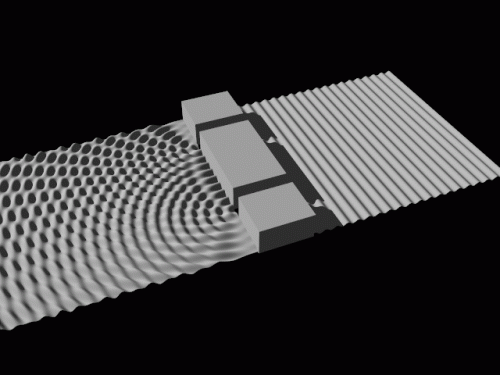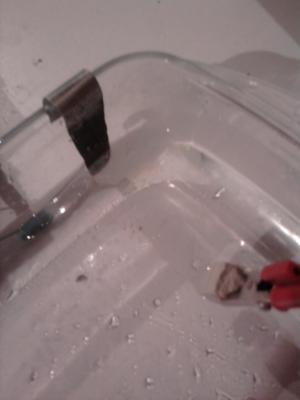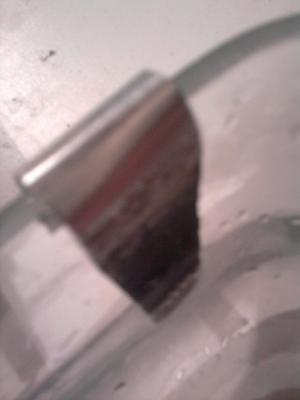-
Posts
7923 -
Joined
-
Last visited
-
Days Won
26
Content Type
Profiles
Forums
Events
Everything posted by Sensei
-
Dear vasileturcu, read about oil drop experiment. http://en.wikipedia.org/wiki/Oil_drop_experiment It's immediately invalidating your theory. Little description: X-rays passing through oil drop that's failing down due to gravitation of Earth, are ionizing oil drop, because some of its electrons are ejected from atoms. Now oil drop possess positive charge. Charged particle placed in strong electric field is slowing down its movement, stopping movement, or even going backward (oil is going from bottom to top of container), depending what voltage and sign we will provide to plates. If Earth would possess positive charge, it could not work this way. The only sensible explanation is that our planet has pretty much neutral charge.
-
By "Oxygen used up" they meant that Oxygen is no longer in free gas form O2. When some molecule is "burned", it's oxidized. For example, if you burn methane: CH4 + 2 O2 -> CO2 + 2 H2O There is produced Carbon dioxide and two molecules of water. Process of producing energy from glucose is more complicated than burning methane and has been described f.e. here http://en.wikipedia.org/wiki/Cellular_respiration#Aerobic_respiration CO2 is removed from living organism by Red blood cells. http://en.wikipedia.org/wiki/Red_blood_cell Plants are using CO2 to build their cells, and giving back O2 to atmosphere. Carbon remains in their cells. Read more about photosynthesis here: http://en.wikipedia.org/wiki/Photosynthesis
-
Example against your theory: 2H2 + O2 -> 2H2O Reactants: 3 total molecules Products: 2 total molecules Reaction is exothermic. Other example: 2 C2H2 + 5 O2 -> 4 CO2 + 2 H2O
-
Who said mass is infinitesimals? If you have 10 kg of Carbon-12 isotope it means it's 10,000 g / 12 g/mol = 833.3 mol. 833.3 * NA = 833.3 * 6.022141*10^23 = 5.01845 * 10^26 atoms of Carbon in 10 kg. You can read more about it http://en.wikipedia.org/wiki/Avogadro_constant http://en.wikipedia.org/wiki/Amount_of_substance http://en.wikipedia.org/wiki/Mole_%28unit%29
-
Hello! On wiki page http://en.wikipedia.org/wiki/Isotopes_of_carbon we can read that decay energy of Carbon-11 isotope is 11C -> 11B + e+ + Ve + 0.96 MeV The first one with 0.96 MeV is correct. I am receiving exactly the same value. 11C + e- -> 11B + Ve + 3.17 MeV But this one, I am not so sure whether it's correct. Can someone point me to other sources mentioning this decay energy of Carbon-11 to verify data.. ? The best would be couple independent sources. After posting I found this http://www.nucleide.org/DDEP_WG/Nuclides/C-11_tables.pdf which mentions 1.982 MeV as decay energy of Carbon-11 (decay through electron capture). And that was mine previously calculated value too (so I was quite surprised that it doesn't match wiki page).. Best Regards!
-

I had a theory for a photon based sensor technology.
Sensei replied to Morthawt's topic in Quantum Theory
I showed photos what result you should expect by placing polarization filters between LED/LCD monitor and your eyes or camera in this thread http://www.scienceforums.net/topic/80366-particle-location/?p=783255 Polarization is described f.e. here http://en.wikipedia.org/wiki/Polarization_%28waves%29 If we have not-polarized source emitting photons (such as laser, Sun or light bulb) to material that is passing through photons with one polarization, and reflecting photons with opposite polarization, you will know which polarization expect from each new beam of photons. These photons are entangled - measure one beam, and you know in advance what result you will have measuring the other one. -
200 MB of text file is not much. Or do you meant 200 GB? If it's 200 MB, you can load it in a few seconds entire to memory in C/C++ code.. If you're seeking for high performance and file size is not an issue, remember to NOT using while( !feof( file ) ) { fgets() } loop which is loading one row at a time. 200 MB will have millions of lines, and it'll be very slow method. Load file at once, then process from memory. Reading chars from memory is fast, even faster if data is in CPU cache. Reading row by row - slow performance. Make a test, and you will see on your own eyes. There is a way to not have to load whole file at once - by using mapping file to memory functions. But it's OS dependent stuff. I am not sure whether you're writing for Windows. If so, here you have description of memory mapping functions: http://msdn.microsoft.com/en-us/library/windows/desktop/aa366537(v=vs.85).aspx I don't know about excel, but txt the most natural obvious method is C/C++ program that is doing while( !feof( file ) ) { fgets() } loop but as I said it's slow. If you don't mind spending couple minutes each time, go ahead use it. But otherwise load whole file at once to memory. Then search in loop for EOL from current memory location (f.e. use strchr() in C/C++). If you will find it, you have whole row, copy it to some buffer, replacing EOL by 0. The buffer will have the same what fgets() would normally return. Then repeat with the rest of original file, incrementing current memory location to char right after EOL of previous row. I don't understand question. It's you who know what data file contains and what format your program will understand.. That's natural that program must check syntax of row of txt data to check whether it contains errors or not. Otherwise wrong data could trash database or crash application. The most efficient way is writing C/C++ application which is using MySQL or other database functions (the most probably through linked library). When whole file is in memory, and db engine supports multi-tasking, and checking syntax of row is taking a lot of time, you can even make program multi-threaded and speed it up even to the number of threads your CPU has (f.e. 8-12 times faster on Core i7+). Simply 1st thread will be analyzing rows in f.e. 1000000 rows, 2nd thread the next million rows, etc.etc, 12th thread will be analyzing rows with offset 11,000,000-11,999,999) If PHP script has to work on 200 MB file, it sounds like nightmare for performance.. It'll be running hundred if not thousands times slower than C/C++ code, even using while( !feof() ) { fgets(); } loop. Better would be writing CGI program (in C/C++) executed by PHP just to process data.
-
Interference doesn't destroy wave.. It looks more like this (it's small version of mine animation of interference effect):
-
Of course I thought about C/C++ as pretty low-level languages. (I even wrote sound card driver for C-Media PCI card 15 years ago) I meant that you don't write driver/OS in f.e. interpreted languages.
-
Not true. You can't make f.e. 3d game with PHP/JavaScript. You can't write drivers using high level languages. You can't make operating system using high level languages. You can't write memory monitor in Java/JS/PHP/Basic. etc. etc. There are many things that won't have sense doing in interpreted language, because the way they are working, program would have to run years to finish.. If you have to use 3rd party library written in C/C++ in some high level language to do something (f.e. render 3d graphics using CPU (pixel by pixel)), it just proves inability of doing it natively in given language.
-
If you have laser with 100 mW max output and 532 nm wavelength, and all energy will convert to photons without loses (idealistically), you will have: 100 mW = 0.1 W = 0.1 J/s E = h*c/wavelength = 6.62607e-34 * 299,792,458 / 532e-9 = 3.734e-19 J each photon energy 0.1 / 3.734e-19 J = 2.678 * 10^17 photons emitted per second
-
When I will buy new Full HD camera I will record new high quality video of these experiments and post. I promise. It was taken quickly using phone at night just to show John.
-
I found a way to work around - zip it.. Chalk electrolysis 2.zip
-
These things are different. Proposition of using one language for everything is reverse to progress.. It's kinda like saying "one bacteria species should be enough for life".. Science is progressing, because some people are doing experiments, and others theoreticians are trying to explain observations. If you would start making experiments and showing them to public on forum, you would get respect and positive reputation. Find new kind of particle, and you will have Nobel in hand It's question not to me, as I have not been in school for 20 years. But I hope so they are learning C/C++ extensively.
-
Imagine that we have photon emitter, and polarization filter or half reflecting mirror, that's reflecting 50% of photons in one direction, and 50% in other direction (or passing through filter). We are performing experiment close to black hole, and one direction is pointing directly to it. Then firing one photon at a time. If we see photon in our detector, we know that this photon went through mirror/filter, and didn't go to black hole. If we don't see photon we know it went to black hole. Just a thought.
-
I am talking about mine experimentally gained experience. Before posting, I have even repeated experiment. You can see there is nothing in between electrode from chalk stick and water: Bubbles of Hydrogen on negative electrode. Quite small amount, because current is low 70 mA (above photo) to 0.13 A (below photo). After adding 5 g of NaCl to water (~1 L), current goes to 0.5 A with distance between them like on above photo: For a while, chalk stick is getting hotter and hotter and starts emitting white fume. Odor is absolutely not equal to SO2/SO3. I have tried different metals which are connected with chalk stick, when I was doing it the first time years ago, and fumes were independent from used metal (if I recall aluminum, steel and copper). For sure metals are going into reaction with chalk stick, there are evidences of this on surface. I have made video of the whole experiment (even three times, because the first attempt was over 2 MB), but SFN refused .mp4 movies (2 MB was enough to have just 43 seconds..) "most" doesn't mean "all". I am pretty sure that mine chalks are made of CaCO3, because I have used them to perform: CaCO3 -> CaO + CO2 and then CaO + H2O -> Ca(OH)2 The all sources in mine native language mention CaCO3 as material for blackboard chalk sticks. And only source mentioning CaSO4 are in English language. Maybe simply we are using different material for them in different countries.. ? In UK majority CaSO4, while here we're making them with CaCO3.. ? Quote from http://en.wikipedia.org/wiki/Blackboard#Chalk_sticks "A blackboard (UK English) or chalkboard (US English; also blackboard) is a reusable writing surface on which text or drawings are made with sticks of calcium sulphate or calcium carbonate," "Sticks of processed "chalk" are produced especially for use with blackboards in white and also in various colours. These are often made not from chalk rock but from calcium sulfate in its dihydrate form, gypsum. Chalk sticks containing calcium carbonate typically contain 40-60% of CaCO3" (open question what's the rest 40-60%) How about performing by yourself some experiments? Put your chalk sticks to HCl. If you will have CO2 bubbles, you will know it's made of CaCO3 (at least to some extent).. Measure volume of produced CO2 and you will know initial concentration of CaCO3 (if there was any).. It's insulator when it's dry. Any insulator can become electric conductor. It's just a matter of voltage. http://en.wikipedia.org/wiki/Breakdown_voltage Yes, I know. I am using it in the cloud chamber particle detectors all the time..
-
Why don't you make experiment by yourself? Chalk you can buy in any stationery shop for penny. That's CaCO3: When we will use chalk as electrode in electrolysis it will become very hot in a few seconds and start to smoke white with nasty smelt and sparks will show up on it.
-
When we have just one slit, photons entering slit in straight line, after exiting slit will be diffracted. It can be visualized in container with water even better. http://www.youtube.com/watch?v=BH0NfVUTWG4
-
Yes. We use the right tool, for right task. To drive a nail we use hammer, not rock or dumbbell (although they would work more or less good for this task). If you would do research before posting, and talk only about things that you know, you wouldn't have reputation points like you have now.. That's natural selection, like in real life. Living languages are evolving, dead languages are dead and nobody knows about them, until finding fossils.. Common language of science is not human language, but mathematics.. No, it's not. If you would know C/C++/PHP/JavaScipt/Java etc. you wouldn't ask such silly questions.. C/C++ is compiled to machine code, one at a time (f.e. 32 bit Intel for Windows). Have direct pointers to memory. Allow low-level manipulation of data. Thus very prone to crashing program or crashing whole computer including restart in the worst scenario. So completely not suitable for servers running web masters programs. PHP is server run interpreted script. Access to low-level of server would cause serious issues with security.. It will never crash server due to error in script.. JavaScript is client run interpreted script. It's run on web browsers, and nowhere else. Java is either interpreted or JIT-compiled. Can be run on either server (f.e. JSP) or client. It's high level, so no memory pointers like in C/C++. PHP, JSP and JavaScript can be mixed with HTML pages seamlessly. Program meant to run on server must be in not compiled form, except CGI (which is C that is writing HTML to stdio). But it's obsolete now. Architecture of server is/should be unknown to web masters.
-
I have not watched video. I am getting -14.637
-
michel123456, visualize now diffraction grating frames with 50 slits/mm, 500 slits/mm and 1000 slits/mm at the same scale as in #10 post. 0.03 mm slits frame would have 16.66(6) slits/mm, if they would be continuous. I check it in 3d application and your scale is correct. I have the same result. We can place ~56 boxes with width 532e-9 m in box with width 3e-5 m.
-
I reedited message, because right value is 0.03 mm, not 0.06 mm "between centers of slits" is direct translation of what's written on it small letters.
-
Find local physics equipment shop and buy stuff.. Like I said, it's very cheap. And also get diffraction grating setup as well (cost $2 for each frame here) I have 1000 slits per mm, 500 slits per mm, and 50 slits per mm. Using laser 532 nm with them, I have number of "blobs" on screen that is always prime number.. And searching for somebody with diffraction grating with different number of slits to compare results. Some kind of plastic. Too small to be measured by me Fraction of mm for sure. In other words: it's x width of slit, then x width of material, then x width of slit. 0.03mm + 0.03mm + 0.03 mm = 0.09mm Looking at it naked eye, you don't know there are two slits.
-
michel123456, you are asking questions like you would never saw Young's experiment in your life... ?! Setup to Young's Experiment I bought for $7 in local physics equipment shop. Laser 100 mW green for $15. It has two frames. One frame with width of slits 0.03 mm Distance between centers of slits 0.06 mm. Second frame with width of slits 0.05 mm Distance between centers of slits 0.1 mm.
-
I am quite surprised. Learning in private Christian USA school means immediately that it'll propagate creationism.. ? Is it not good reason to get child out from it.. ?





